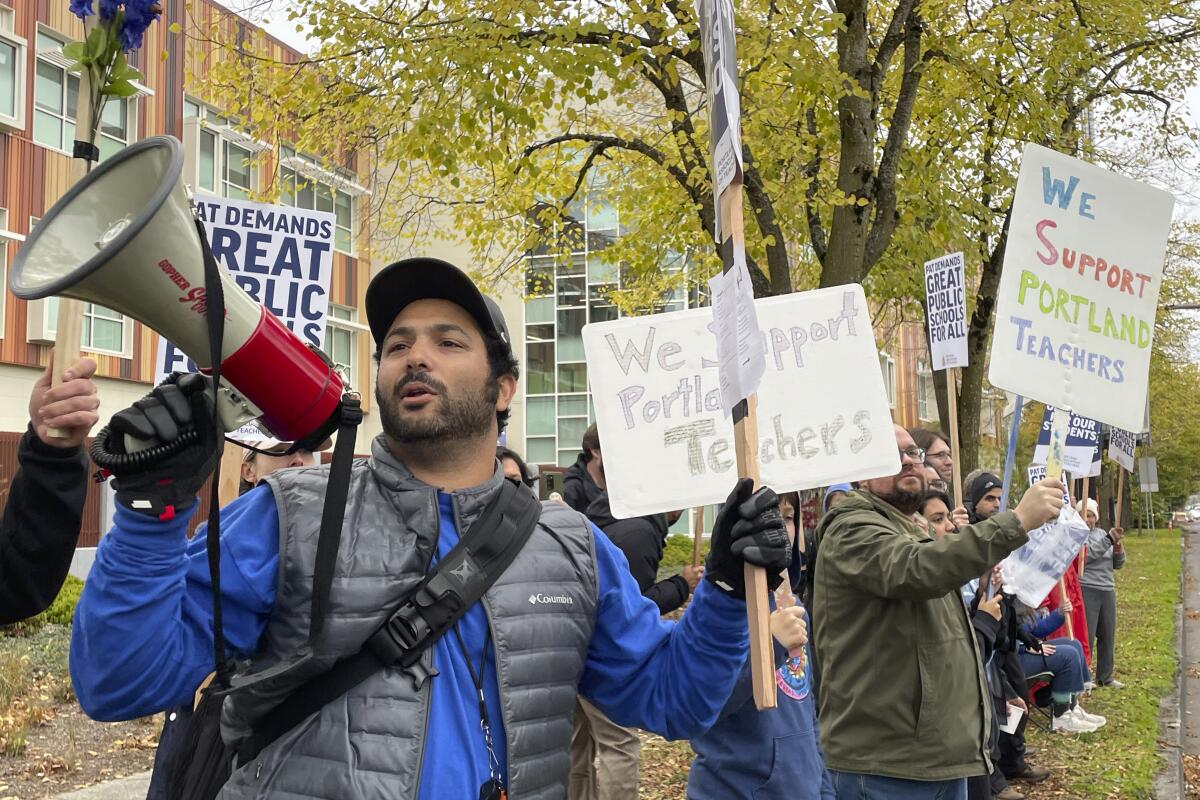Teachers kick off strike in Portland, Ore., over class sizes, pay and resources

- Share via
PORTLAND, Ore. — Teachers in Portland, Ore., walked off the job on Wednesday for the first day of a strike that shuttered schools for some 45,000 students in Oregon’s largest city.
Concerns over large class sizes, salaries that haven’t kept up with inflation and a lack of resources prompted the strike, one of the latest signs of a growing organized labor movement in the U.S. that’s seen thousands of workers in various sectors take to the picket lines this year.
“Our kids deserve more than teachers that are absolutely exhausted and at the end of their ropes,” said Sarah Trapido, a special education teacher at Kellogg Middle School.
The Portland Assn. of Teachers, which represents more than 4,000 educators, said it was the first-ever teachers’ strike in the school district. The union has been bargaining with the district for months for a new contract after its previous one expired in June.
Portland, Ore., long a famously progressive city, faces a crisis of confidence as it grapples with homelessness and crime. Residents can’t agree on solutions.
Portland Public Schools did not respond to requests for comment on Tuesday night or Wednesday morning. Schools are closed and there is no classroom or online instruction during the strike.
Teachers held signs, chanted and rallied the crowd with bullhorns outside of Kellogg Middle School on Wednesday morning as cars passing by honked in support. Educators said they feel overwhelmed by their workload and what they described as a lack of support in the classroom.
Trapido said she regularly works through her lunch break and continues once she gets home until 8 or 9 p.m. She often relies on a volunteer to help with her students.
“She walks in and I’m just like, ‘Thank goodness,’” Trapido said. With the volunteer’s help, she said, she can help a child go to the bathroom, get herself a drink of water — which she might not have had all day — or help a group that she hasn’t had a chance to work with.
Katarina Juarez, an eighth-grade language arts teacher at Kellogg Middle, said she often stays at school until 7 p.m. to get her work done. Doctors have suggested that she quit because of the toll her job has taken on her mental health, she said.
Voters in Portland, Ore., driven in part by frustration with surging homelessness, have approved a measure that will completely reinvent City Hall.
“I feel like I’m failing them if I’m not putting that time in,” she said. “But I’m really harming myself and my family in the process.”
Mike Bauer, a union representative and special education teacher at Cleveland High School, said teachers were stressed about the strike but felt it was the right way to advocate for their students. He said that smaller class sizes would both lighten educators’ workload and help them give students more individualized attention if they’re struggling.
“It’s about the kids,” said Bauer, who’s been teaching in Portland for nearly 20 years. “It’s about the sustainability of the job and the longevity of our jobs.”
Questions of pay — particularly for teachers just starting their career — have also been raised as the cost of living has increased in Portland, he said. The annual base salary in the district starts at roughly $50,000.
“I’ve seen many people quit within their first five years,” he said. “At the end of the day, we need teachers.”
Homeless encampments now spill well beyond Portland’s downtown core, dividing a city that has invested liberally in support services.
Nearly two weeks ago, the union announced that 99% of teachers voted in favor of the labor action, with 93% of its members participating in the ballot.
After the union voted to authorize the strike, the district said it wanted to reach a fair settlement. “We ask our educators to stay at the table with us, not close schools,” it said in an emailed statement on Oct. 20.
Oregon Gov. Tina Kotek had urged the union and the school district to come to an agreement and avoid a walkout.
Public education has been gripped by a series of high-profile strikes this year.
In the Los Angeles Unified School District, the nation’s second-largest, workers including teachers’ aides, cafeteria workers and custodians walked out for three days in March to demand better wages and increased staffing, shutting down education for half a million students.
In Oakland, the union representing teachers, counselors, librarians and other workers went on strike for more than a week in May. In addition to typical demands such as higher salaries, it also pushed for “common good” changes, such as reparations for Black students and resources for students who are homeless.
More to Read
Sign up for Essential California
The most important California stories and recommendations in your inbox every morning.
You may occasionally receive promotional content from the Los Angeles Times.
















